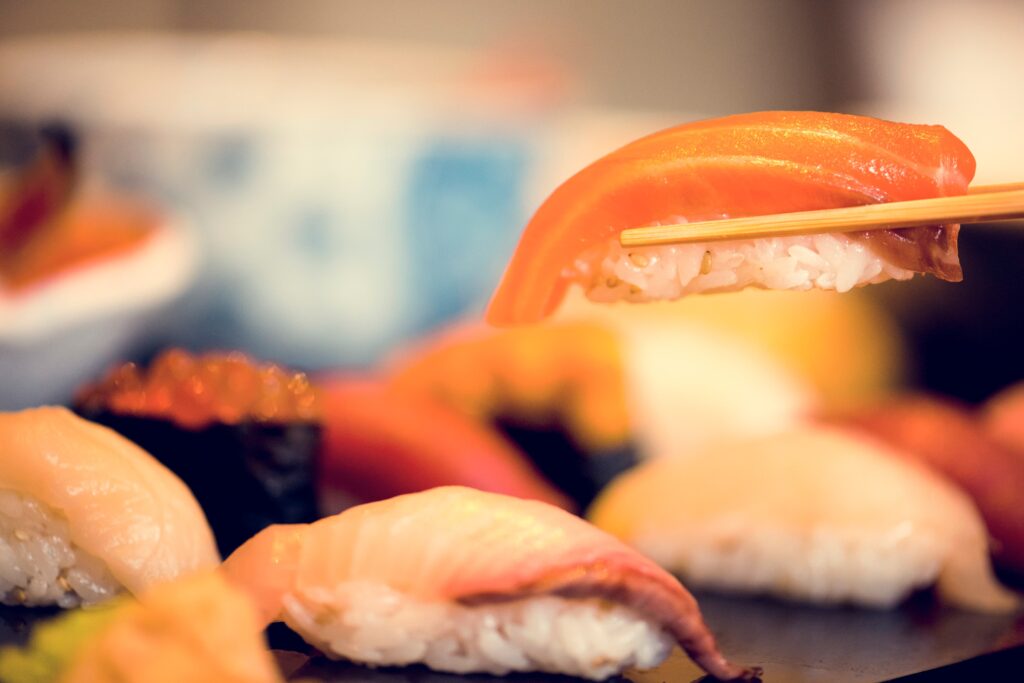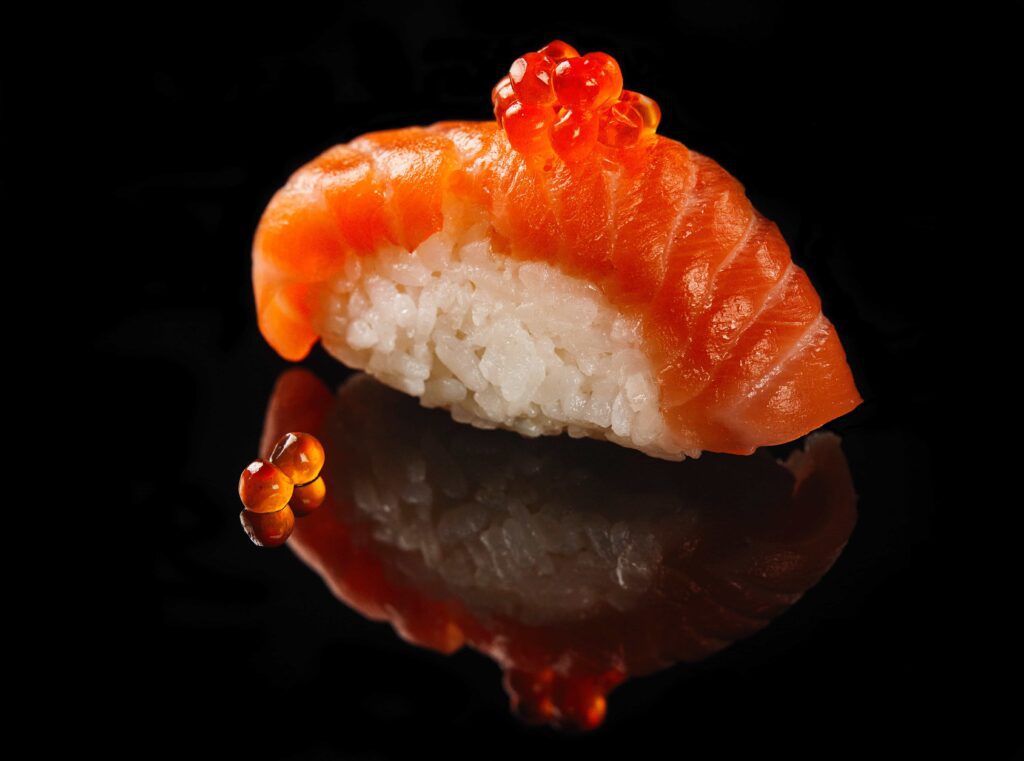While most people picture sushi as a rolled-up treat, that’s only one style. Sushi comes in many forms–and nigiri is one of the most beloved.
In this guide, you’ll learn what nigiri is, how it’s made, and what types to look for on your next sushi night out.
What Is Nigiri?
Nigiri is a simple yet delicious type of sushi. It’s made with a small, hand-shaped mound of vinegared rice, topped with a slice of fish or another tasty ingredient. Unlike sushi rolls, nigiri isn’t wrapped in seaweed or filled with extra toppings. Everything sits neatly on top—clean, elegant, and packed with flavor.
Meaning
The word nigiri comes from the Japanese word nigiru, which means “to grasp” or “to squeeze.” This refers to how the sushi is made—chefs gently press the rice by hand to shape it. No rolling, no cutting—just careful, practiced movements to create something beautifully simple.
How It Differs from Other Sushi
Nigiri is different from other popular types of sushi like maki and sashimi:
Maki is rolled sushi, wrapped in seaweed and often filled with vegetables, sauces, and sometimes fried ingredients.
Sashimi is just slices of raw fish served without rice.
Nigiri sits right in the middle: hand-formed rice on the bottom, a single topping on top, and no extras. It’s minimal but flavorful, letting the freshness of the ingredients shine.

The Art of Making Nigiri
Nigiri might look simple, but making it takes real skill. Sushi chefs train for years to perfect every detail—from slicing fish to shaping the rice just right. The rice needs to hold together gently–sticky enough to maintain its shape but still light and airy, and the topping needs to be evenly cut to rest neatly on top.
Every piece is a small work of art, and it’s usually made fresh to order.
Selecting Ingredients
The secret to amazing nigiri? Top-quality ingredients.
Rice
Sushi rice is seasoned with vinegar, sugar, and salt. It needs to be warm, fluffy, and just sticky enough to hold its shape.
Fish and Toppings
Nigiri is often made with raw fish like tuna or salmon, but cooked items like shrimp, eel, and even sweet egg are common. The key is freshness—ingredients should be clean, flavorful, and, when raw, of sushi-grade quality.
Shaping the Rice
Each ball of rice is formed by hand into a small, oval shape—usually about two fingers wide. Chefs press just enough to hold it together, but not so much that it becomes dense or gummy. Finding that perfect balance takes time and practice, which is why well-made nigiri feels so light and delicate.
Pairings
Nigiri is usually served with a few simple sides:
Soy sauce: Just a light dip is all you need.
Wasabi: Traditional nigiri often includes a small dab between the fish and rice, added by the chef. If not, you can add a tiny dab yourself.
Pickled ginger: Eaten between bites to refresh your palate.
For drinks, try green tea, sake, or a light Japanese beer to keep the flavors balanced and refreshing.

Popular Types of Nigiri
There are many toppings that can go on nigiri. Here are some of the most popular choices you’ll find at sushi restaurants:
Maguro (Tuna)
Tuna nigiri is a fan favorite. The fish is deep red, smooth, and has a mild flavor that pairs beautifully with rice.
Sake (Salmon)
With its rich orange color and buttery texture, salmon nigiri is slightly sweet and melts in your mouth.
Unagi (Eel)
Unagi is grilled eel, brushed with a sweet, savory sauce. Since it’s cooked, it’s a great option if you’re not quite ready for raw fish.
Tamago (Sweet Egg)
Tamago is a sweet, layered Japanese omelet, often served with a strip of seaweed to hold it in place. It’s a tasty, kid-friendly choice too!
Dining Out For Nigiri
What to Expect
When you order nigiri at a restaurant like Kobe Japanese Steakhouse, each piece is made fresh. It often comes in pairs and may be lightly brushed with soy sauce or topped with wasabi. Don’t be surprised if your plate looks like a piece of art—presentation is an essential part of the experience.
You can order nigiri à la carte or choose a combo to try a variety of types.
Etiquette and Best Practices
Eating nigiri isn’t complicated, but here are a few tips to make your meal even better:
One bite (if you can): Nigiri is made to be small enough to eat all at once.
Dip lightly: If you use soy sauce, dip the fish side—too much soy can overpower the delicate flavors.
Hands or chopsticks: Either is fine, so go with what’s comfortable.
Ginger between bites: Pickled ginger helps cleanse your taste buds so you can enjoy each piece fully.

Try Nigiri at Kobe Japanese Steakhouse
Whether it’s your first time trying sushi or you’re already a fan, nigiri is a great way to experience pure, fresh flavor in every bite.
At Kobe Japanese Steakhouse, our skilled sushi chefs prepare each piece with care using only the best ingredients.
Join us and explore our full sushi menu from the comfort of our dining room—or pull up a seat at our world-class sushi bar for an up-close look at the action.
Prefer to dine at home? We’ve got you covered with carryout, delivery, and catering options, so you can enjoy your favorites anytime, anywhere.